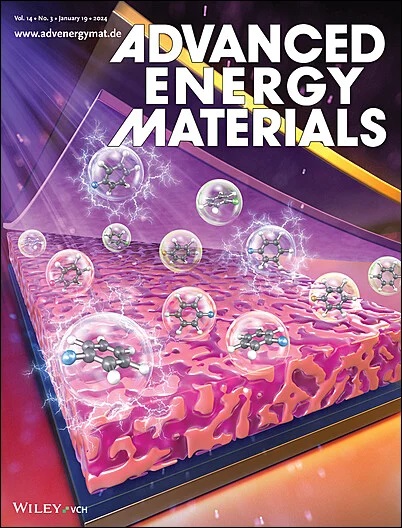Thermally Cured Sulfonated para-PBI as Ion Solvating Membrane for Use in Water Electrolysis
IF 24.4
1区 材料科学
Q1 CHEMISTRY, PHYSICAL
引用次数: 0
Abstract
A sulfonated para-polybenzimidazole (MS-PBI) membrane is thermally cured at 350 °C for 120 minutes. The thus obtained cMS-PBI membrane is insoluble in hot phosphoric acid solution (<5% soluble fraction), and is free of the known breaking points under alkaline conditions, i.e., no aromatic ether bonds, no quaternary ammonium groups, no N-alkylated neutral or positively charged imidazole groups. Indeed, a 6 months long alkaline stability test in 2 M KOH at 80 °C shows that cMS-PBI retains its dimensions and its weight without any sign of degradation. The room temperature conductivity increases within the first 24 days, and then remains constant at 192 ± 10 mS cm−1. At 80 °C, the conductivity in 3 M KOH reaches 682 mS cm−1. At 80 °C and with 2 M KOH feed solution, an electrolyzer using robust nickel foam electrodes has a performance of 0.975 A cm−2 at 2 V. With NiFe/Raney nickel, 3.52 A cm−2 (extrapolated) at 2 V are reached. Voltage remained stable in a 200 hours test. In conclusion, it is expected that ion solvating membranes like cMS-PBI can substitute anion exchange membranes in water electrolyzers, and by this improve their lifetime and reduce the cost of green hydrogen.

求助全文
约1分钟内获得全文
求助全文
来源期刊

Advanced Energy Materials
CHEMISTRY, PHYSICAL-ENERGY & FUELS
CiteScore
41.90
自引率
4.00%
发文量
889
审稿时长
1.4 months
期刊介绍:
Established in 2011, Advanced Energy Materials is an international, interdisciplinary, English-language journal that focuses on materials used in energy harvesting, conversion, and storage. It is regarded as a top-quality journal alongside Advanced Materials, Advanced Functional Materials, and Small.
With a 2022 Impact Factor of 27.8, Advanced Energy Materials is considered a prime source for the best energy-related research. The journal covers a wide range of topics in energy-related research, including organic and inorganic photovoltaics, batteries and supercapacitors, fuel cells, hydrogen generation and storage, thermoelectrics, water splitting and photocatalysis, solar fuels and thermosolar power, magnetocalorics, and piezoelectronics.
The readership of Advanced Energy Materials includes materials scientists, chemists, physicists, and engineers in both academia and industry. The journal is indexed in various databases and collections, such as Advanced Technologies & Aerospace Database, FIZ Karlsruhe, INSPEC (IET), Science Citation Index Expanded, Technology Collection, and Web of Science, among others.
 求助内容:
求助内容: 应助结果提醒方式:
应助结果提醒方式:


